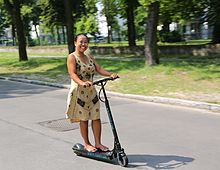Kick scooter
[1] A company that had once made the Razor Scooters revitalized the design in the mid-nineties and early two-thousands.
Kick scooters have been handmade in industrial urban areas in Europe and the United States since the 1920s or earlier, often as toys made for children to roam the streets.
[2] One common home-made version is made by attaching roller skate wheelsets to a board with some kind of handle, usually an old box.
An alternative construction consists of one steel clamp on a roller skate divided into front and rear parts and attached to a wood beam.
The German Bundesarchiv for "roller" details that both homemade and manufactured children's scooters were used and even raced in Paris, Berlin and Leipzig in 1930, 1948 and 1951.
[10] In 1990, a foldable aluminium scooter with inline skates wheels was created by Wim Ouboter[11] of Micro Mobility Systems in Switzerland.
[14] The Razor was introduced to Japan in 1999, with many early adopters being young Japanese who used it for portable transport.
Numerous brands specialize in stunt scooters and accessories including lightweight and high strength parts, helmets, pads, ramps, grind wax, griptape, grips, bearings and clothing.
[19] In 2006, a company called Nextsport started producing a line of four-wheeled scooters, known as Fuzions.
Shared electric kick scooters have also made a certain contribution to environmental protection, because they do not emit greenhouse gases, reduce traffic congestion and reduce the need for public transportation, however they are most sustainable when they are "replacing personalized individual transport".
[21] Electric scooters are also available for personal use, with manufacturers such as TurboAnt offering models designed for individual ownership.







